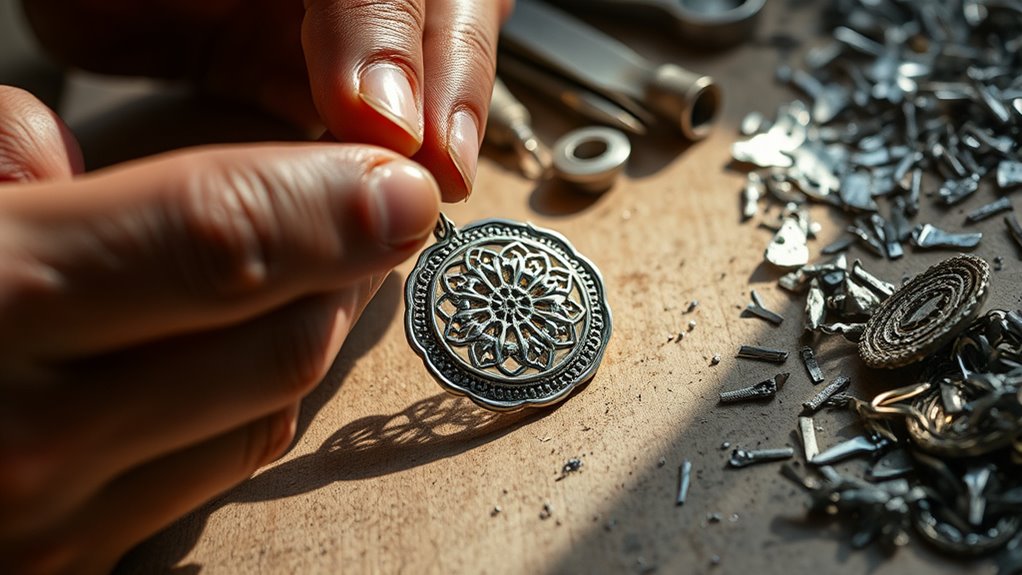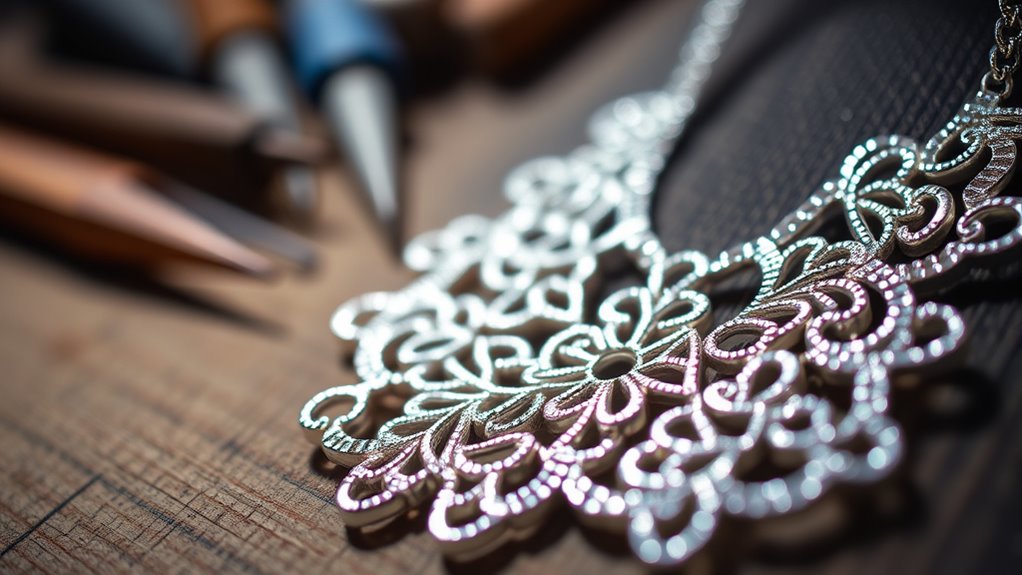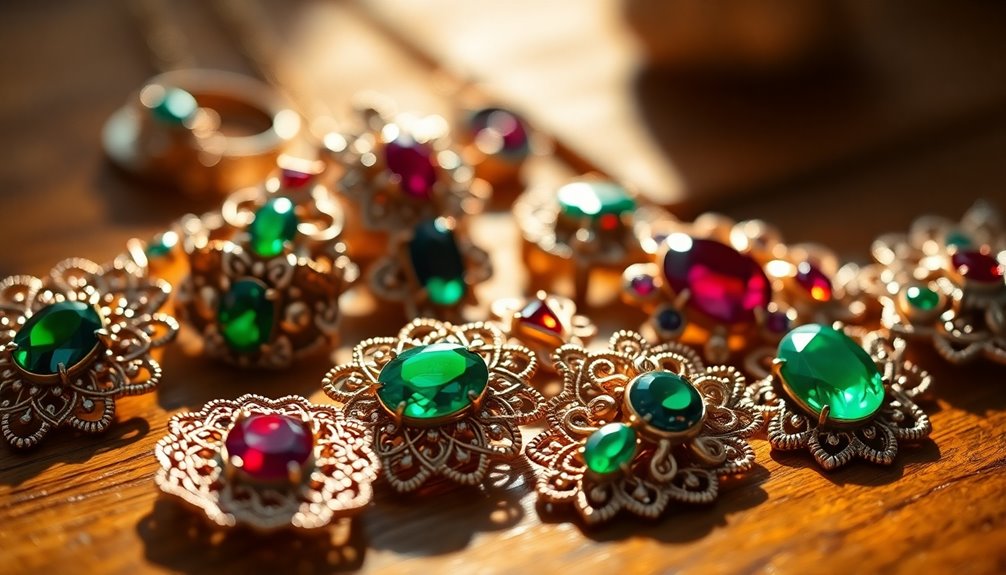Artisanal silver worldwide showcases diverse techniques rooted in local culture, history, and craftsmanship. In Mexico, artisans use hand-forging, repoussé, and chasing to depict indigenous symbols, while Indian silversmiths excel in delicate filigree work representing spiritual stories. Thailand often employs casting and engraving to craft mythological themes. Each region’s unique methods reflect their traditions, making every piece a one-of-a-kind cultural expression. If you explore further, you’ll uncover even more about these fascinating craftsmanship techniques.
Key Takeaways
- Different regions utilize unique techniques like hand-forging, repoussé, filigree, and casting to craft artisanal silver.
- Mexico emphasizes indigenous symbols through traditional silversmithing methods, blending history with craftsmanship.
- India is known for intricate filigree work, weaving fine silver threads into symbolic patterns.
- Thailand specializes in casting and engraving, creating mythologically themed silver pieces.
- These regional techniques preserve cultural heritage and highlight local artistic identities.

Have you ever wondered what makes artisanal silver so unique? It’s the rich handcraft tradition that has been passed down through generations, each piece telling a story beyond its form. When you hold a silver artifact created by skilled artisans, you’re holding more than just a piece of jewelry or decor—you’re experiencing a cultural legacy. These artisans dedicate hours, sometimes even days, to perfect their craft, blending age-old techniques with their personal touch. This tradition isn’t just about making beautiful objects; it’s about preserving a way of life rooted in history and community. Every swoop of the hammer, every delicate engraving, carries cultural significance that connects the maker to their ancestors and the customs of their homeland. This deep cultural narrative is what distinguishes artisanal silver from mass-produced items.
Across the globe, different regions have developed their own unique techniques, each imbued with local traditions and beliefs. In Mexico, for example, artisans often use the traditional “silversmithing” method, combining hand-forging with intricate repoussé and chasing to create detailed motifs that reflect indigenous symbols and stories. Meanwhile, in India, artisans might incorporate detailed filigree work, where fine silver threads are twisted and woven into intricate patterns that symbolize spiritual beliefs or local folklore. In Thailand, artisans excel at casting and engraving, creating pieces that feature mythological themes and historical motifs. These diverse techniques highlight how artisanal silver serves as a canvas for cultural expression, making each piece a meaningful artifact rather than just a decorative object.
The handcraft tradition also guarantees that each piece is unique. Unlike machine-made jewelry, artisanal silver is marked by slight imperfections and individual nuances, which add to its charm and authenticity. When you buy or wear artisanal silver, you’re appreciating the skill and patience of the craftsperson who poured their expertise into every detail. This connection to tradition fosters a sense of pride for both the maker and the wearer, emphasizing the cultural significance embedded in each item. Furthermore, supporting artisanal silver helps keep these time-honored techniques alive, ensuring that future generations can continue to celebrate their heritage through their craft. Ultimately, artisanal silver isn’t just about aesthetics; it’s a living expression of cultural identity, skill, and tradition that enriches your appreciation for handcrafted artistry.
Frequently Asked Questions
How Long Does It Take to Master Artisanal Silver Techniques?
It takes several years of dedicated practice for you to master artisanal silver techniques. Skill development varies depending on the complexity of the techniques and your commitment, but consistent effort accelerates your progress. You might see noticeable improvement in a year, yet true technique mastery often requires five or more years. Stay persistent, learn from experts, and practice regularly to refine your skills and achieve proficiency in artisanal silver craftsmanship.
What Are Common Tools Used in Traditional Silver Crafting?
You use a variety of tools in traditional silver crafting, including silver mallets to shape and flatten the metal, pliers for gripping and bending, and saws to cut intricate designs. These tools help you attain precise details and craftsmanship. Mastering their use takes practice, but with patience, you’ll develop skill in manipulating silver for beautiful jewelry and decorative pieces. Proper tool handling guarantees quality results and enhances your creative process.
How Do Cultural Influences Shape Silver Design Styles Globally?
Ever wondered how cultural symbolism and regional motifs influence silver design styles? You see, these elements shape jewelry by reflecting local stories, beliefs, and traditions, making each piece unique. For example, intricate patterns in Indian silver jewelry often symbolize spirituality, while Native American motifs emphasize nature and heritage. Your appreciation deepens as you recognize that cultural influences breathe life into silver designs, creating a rich tapestry of global artistry.
What Safety Precautions Are Necessary During Silver Smithing?
When silver smithing, you need to prioritize workspace safety by wearing protective gear like goggles, gloves, and a dust mask. Make sure your workspace is well-ventilated and free of clutter to prevent accidents. Always handle tools carefully, keep fire hazards away, and follow safety guidelines for soldering and polishing. Staying alert and cautious helps you avoid injuries and guarantees a safe, productive environment.
Can Artisanal Silver Techniques Be Adapted for Modern Jewelry?
Imagine transforming a vintage map into a modern masterpiece—artisanal silver techniques can indeed be adapted for today’s jewelry. You’ll blend historical authenticity with market adaptation, giving your creations a timeless yet contemporary appeal. By integrating traditional methods like hand-engraving or repoussé into modern designs, you create unique pieces that resonate emotionally and stand out in a crowded market, making your jewelry both meaningful and market-ready.
Conclusion
As you explore artisanal silver, you might find yourself enchanted by its subtle charm and timeless techniques. Every handcrafted piece whispers stories from distant lands, inviting you to appreciate the delicate artistry behind each creation. Embrace the journey of discovery, where tradition and craftsmanship gently intertwine. Let these exquisite techniques inspire your own appreciation for the beauty that arises when passion meets patience. After all, some treasures are best appreciated softly, revealing their true magic over time.










